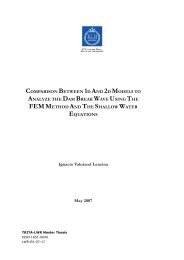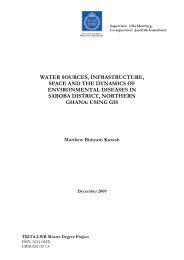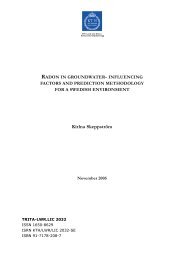Chen Shi TRITA LWR Degree Project 12:37method that is introduced in this paper, anaerobic digestion of fish wasteand by-catch. It can decompose fish waste and by-catch under theoxygen free condition to produce biogas used as a renewable energysource.The benefits from AD are performed in two aspects, i.e. energy resourceand environmental protection. As a renewable source, biogas can beused not only as heat and electricity, but also as fuel for vehicles insteadof fossil fuel. In addition, it is better than wind and solar power withoutconsidering the weather and lighting time effect factors. The location forbiogas plant is flexible. Furthermore, the slurry in the digester is also avaluable source including nitrogen, phosphorous and potassiumelements that can be used as fertilizer. On the other hand, with regard toenvironment, AD can lessen the quantity of waste and the cost of wastedisposal, as well as the risk of odor problem during slurry spreading.Besides, biogas collection can reduce the Green House Gas emission andbe friendly to environmental protection (Seadi et al, 2008). Consequently,more and more biogas collection is what humans expect today undersuch harsh conditions of the greenhouse effect and energy shortagecrisis.1.2. Project descriptionSimrishamn is located in Skåne, Sweden, which is one of the largestfishing ports in Baltic Sea. The fishermen in that area put moreconcentration on caring about environmental disposal of fish waste andby-catch to protect the marine environment and keep its developmentsustainable.By the commission of the fishery industry in Simrishamn, the research ofAD of fish wastes from cod and by-catch had been conducted atlaboratory scale using AMPTS II at the Swedish EnvironmentalResearch Institute (IVL) in Hammarby Sjöstadsverk since September,2011. At the first phase of this research, the feasibility of biogasproduction from fish wastes and by-catch with other variable substrateswas verified by Almkvist (2012). In the light of his result, Tomczak-Wandzel (personal communication, February 2012) had interpreted thatmixing inoculums from Henriksdal WWTP with substrates (fish waste,by-catch and sludge) as 3:2 could obtain the highest biogas potential after20 days. Both experiments will be introduced in detail at the 2.4 section.In this paper, the analysis of biogas production was continually carriedout by mixing different ratios of three substrates (fish waste, by-catchand sludge) with the same inoculums at 37 ± 0.5 ºC.1.3. Purpose of the projectThe purpose of this project is to get the optimal biogas potential fromdifferent ratios of fish waste, by-catch and sewage sludge, in order tomake the disposal of fish wastes and by-catch more efficiently,sustainably and environmentally to the Baltic Sea.2. BACKGROUNDThe development of regulations on disposal of fish wastes and by-catchis introduced in brief in this chapter. Moreover, general descriptions ofanaerobic digestion and affected factors are presented. In addition, theprinciple of this project analysis and pre-study are illustrated likewise.2
Potential Biogas Production from Fish Waste and Sludge2.1. Regulations on disposal of fish wastes and by-catchIn order to protect the marine environment from human activities, 1996Protocol to the 1972 Convention on the Prevention of Marine Pollutionby Dumping of Wastes and Other Matter (1996) was implemented in2006, administrated by International Maritime Organization (IMO),which forbids all dumping of wastes into the sea, except for a list ofpossibly acceptable wastes, such as ‘fish waste or material resulting fromindustrial fish processing operations’. However, on 23 rd November, 2011,the ministers of fisheries in Norway, Sweden and Denmark signed a jointdeclaration prohibiting the fish dumping into Skagerrak in order toimprove the marine environment and achieve sustainable managementof marine resources in the future. It will be implemented on 1 st January,2013 (Ministry of Fisheries and Coastal Affairs, 2011) and could be thedeveloping trend for the fisheries to protect the marine environment inthe future. The enacted ban of discards, as one of the most essentialissues on the international agenda, attracts many other costal states’attention.Therefore, how to dispose fish waste and by-catch will be a bigchallenge to the fisheries not only in these three countries, but alsoglobally.2.2. Anaerobic digestionThe biogas production from degrading high content of organic matterbiologically has been known since 1630 by Von Helmont and 1667 byShirley. However, the presence of CH 4 in the biogas was proved until1808 when Sir Humphrey Davy researched the AD of manure. After 76years, the use of biogas was presented by Louis Pasteur, such as heatingand lighting (Solmaz & Peyruze, 2009).2.2.1. The process of anaerobic digestionThe microbiological process of AD is the process of complex organicmaterials decomposed by many groups of microorganisms in the oxygenfree condition. The final products from AD are digestate including avariety of nutrients, and biogas containing CH 4 (50 %-75 %), CO 2(25 %-45 %) and few by-products such as H 2S (
















